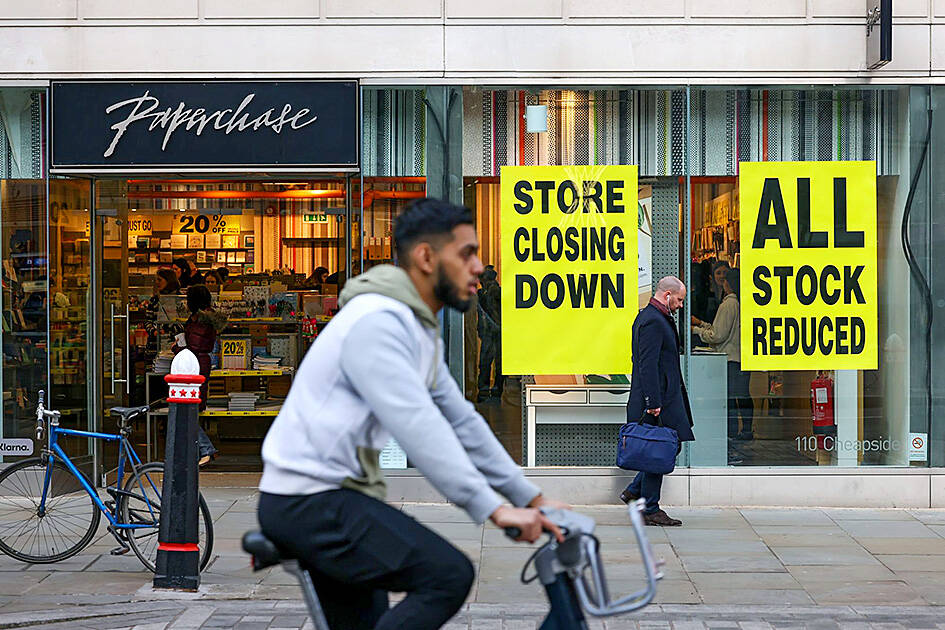Nearly 15,000 British retail jobs have been cut since last month in a “brutal start to the year” for the high street.
A total of 14,874 retail job losses have been announced by companies so far, research by the Centre for Retail Research (CRR) found.
National retailers, including stationery brand Paperchase, clothing chain M&Co and Tile Giant Ltd, have all gone bust in the past few weeks, while discount retailer Wilko Ltd, clothing retailer New Look Ltd, and supermarkets Tesco PLC and Asda Stores Ltd have all announced job cuts.

Photo: Bloomberg
Large retail chains, which have 10 or more stores, are among those cutting jobs on UK high streets, as well as at main shopping destinations, the research found.
Most of the job losses — totaling 11,689 — are at large retailers, including Tesco and Asda, who are carrying out cost-cutting programs and restructuring operations.
Meanwhile, a further 3,185 jobs have been lost at large retailers that have collapsed and are undergoing insolvency proceedings.
Embattled stationery specialist retailer Paperchase Products Ltd fell into administration last month, after being hit by rising costs and disappointing sales.
The brand and its intellectual property was bought by Tesco, but the deal did not include taking on Paperchase’s 106 stores in the UK and Ireland, prompting the loss of 250 jobs, with an uncertain future for the remaining 500 staff.
Many retailers have already collapsed in the past few years, CRR director Joshua Bamfield said.
“The process of rationalization will continue at pace as retailers continue to reduce their cost base,” he said. “We are unlikely to see any respite in job losses in 2023 after a brutal start to the year.”
Retail job losses have been mounting for several years, even prior to lengthy closures after repeated COVID-19 lockdowns.
Just under 3 million people were employed in retail in the second quarter of last year — 63,000 less than a year earlier, a British Retail Consortium survey found.
A revaluation of business rates, which are among the largest operating costs for retailers, is taking place from April 1, and looks likely to reduce the rateable values used to determine bills.
Business rates relief means that new bills would be discounted by 75 percent for the tax year from April to the end of March next year, up to a cash cap of £110,000 (US$132,551) per business, as British Chancellor of the Exchequer Jeremy Hunt announced in his autumn statement.
His Majesty’s Treasury has said that the retail sector “is set to see its overall bills paid fall by 20 percent” as a result.
However, property adviser Altus Group is saying that most retailers with multiple stores are only expected to benefit from the discount on a handful of their branches because of the cap.
“While the adjustments brought about by the revaluation are welcome, 10 percent overall just does not go far enough given the state of the market on the valuation date, which is likely to lead to a tsunami of appeals,” Altus Group global president of property tax Alex Probyn said.

UNCERTAINTIES: Exports surged 34.1% and private investment grew 7.03% to outpace expectations in the first half, although US tariffs could stall momentum The Chung-Hua Institution for Economic Research (CIER, 中華經濟研究院) yesterday raised its GDP growth forecast to 3.05 percent this year on a robust first-half performance, but warned that US tariff threats and external uncertainty could stall momentum in the second half of the year. “The first half proved exceptionally strong, allowing room for optimism,” CIER president Lien Hsien-ming (連賢明) said. “But the growth momentum may slow moving forward due to US tariffs.” The tariff threat poses definite downside risks, although the scale of the impact remains unclear given the unpredictability of US President Donald Trump’s policies, Lien said. Despite the headwinds, Taiwan is likely

When Lika Megreladze was a child, life in her native western Georgian region of Guria revolved around tea. Her mother worked for decades as a scientist at the Soviet Union’s Institute of Tea and Subtropical Crops in the village of Anaseuli, Georgia, perfecting cultivation methods for a Georgian tea industry that supplied the bulk of the vast communist state’s brews. “When I was a child, this was only my mum’s workplace. Only later I realized that it was something big,” she said. Now, the institute lies abandoned. Yellowed papers are strewn around its decaying corridors, and a statue of Soviet founder Vladimir Lenin

UNIFYING OPPOSITION: Numerous companies have registered complaints over the potential levies, bringing together rival automakers in voicing their reservations US President Donald Trump is readying plans for industry-specific tariffs to kick in alongside his country-by-country duties in two weeks, ramping up his push to reshape the US’ standing in the global trading system by penalizing purchases from abroad. Administration officials could release details of Trump’s planned 50 percent duty on copper in the days before they are set to take effect on Friday next week, a person familiar with the matter said. That is the same date Trump’s “reciprocal” levies on products from more than 100 nations are slated to begin. Trump on Tuesday said that he is likely to impose tariffs

READY TO BUY: Shortly after Nvidia announced the approval, Chinese firms scrambled to order the H20 GPUs, which the company must send to the US government for approval Nvidia Corp chief executive officer Jensen Huang (黃仁勳) late on Monday said the technology giant has won approval from US President Donald Trump’s administration to sell its advanced H20 graphics processing units (GPUs) used to develop artificial intelligence (AI) to China. The news came in a company blog post late on Monday and Huang also spoke about the coup on China’s state-run China Global Television Network in remarks shown on X. “The US government has assured Nvidia that licenses will be granted, and Nvidia hopes to start deliveries soon,” the post said. “Today, I’m announcing that the US government has approved for us